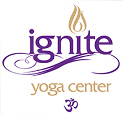Monthly Poses & Students
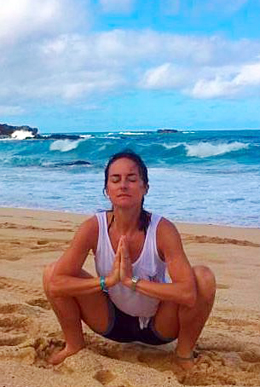
March Pose of the Month – Malasana”
(Greeting Pose)
By: Daniele Jarman
How to do Malasana”
Malasana or Greeting Pose is the name for a variety of Yogic Squats. Squatting used to be an ordinary posture for our ancestors and still is common in many cultures. In the west we sit. We sit at our desk, in front of our computers, in front of the TV and in our cars. We have become accustomed to having our bodies set in a 90-degree angle. Malasana is one of the poses that counters the positions of sitting and slouching.
Some of the Benefits of Malasana:
• Aids in digestion
• Stretches your ankles, lower hamstrings and back
• Keeps hip joints and pelvis on a healthy
• Strengthens your metabolism and abdominals
• Great for prenatal yoga
The benefits are great but in every asana most importantly take care of your body by practicing Ahimsa nonviolence to yourself. If you have any low back or knee issues do not go all the way into a squat. One can also take support with a block under your sit bones. Feet should be flat. If that is not happening yet roll up a blanket or your mat under your heels.
Practice this asana on and off your mat!
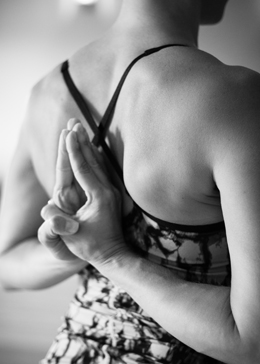
March Students of the Month – YOU!
The Kula and Community of Ignite
By Daniele Jarman
We value and appreciate each of you and strive to be of service with each and every class. We value and welcome your input so please feel free to contact us with your suggestions, thoughts and ideas.
Our Mission
“To teach yoga as a practice of self discovery
in an environment that is warm and nurturing”

February Pose of the Month – Padmasana – (Lotus Pose)
By: Agnes Tengerdy
How to do Padmasana
Most people fear to approach yoga because there are famous, ancient images of yogis sitting in lotus pose which makes our legs look like a pretzel. Padmasana is a tricky pose and personally took me almost 6 years of every day practice after my multiple knee/femur surgeries until I could perform it with confidence. Even today there are few days when I respect the weakness/swollenness caused by the weather or previous day activities and simply avoid doing it.
Also took me years to fully feel the energetic benefits and understand why this pose is a symbol of perfection and that we can invoke our higher self through it.
Before attempting Lotus Pose, the legs, ankles and knees have to be very flexible which can take long years of regular practice. We have to be careful with the kneecaps and ligaments because once they are damaged we can have permanent problems. Very few people can hold Padmasana for a longer period of time but when it is achieved, energetic doors can open up in the spiritual realm for us. The pose balances prana (life force) and said to be the destroyer of disease. It brings changes to the metabolic structure as well as in the brain patterns since the blood flow in our instinctual part (legs representing fear, survival in the root chakra) is decreased the body can focus more on higher activities.
For years I could start building Padmasana only with my left leg therefor in the Ashtanga tradition I was told off many times (they start everything with the right side) but I still did it and imagined myself reversing the movement, after some time it finally happened.
Keep trying it every week, one day you might surprise yourself after a good warm up!
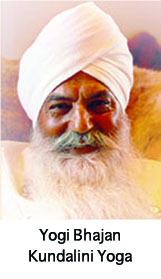
February Student of the Month – Joe Zsombik
By Agnes Tengerdy
When I met Joe 3 years ago I did not think of him as a typical yogi. His body is not the average bony, slender type. He was currently at a teacher training program and started to teach Kundalini Yoga right after he accomplished it. As he became regular at Ignite, showing up in the early morning (Sadhana) hours, before the sunrise to meditate and perform Kriyas I was impressed more and more by his consistency, discipline and strong neutral mind. For me he is the perfect proof that yoga does not mean only poses on the mat it is mind over matter, soul over ego, disciplin beyond limitations. He keep inspiring me until today with his love for yoga and he is open to several styles of yoga such as Hatha, Vinyasa Flow besides Kundalini.
Meet Joe:
Q: When did you begin practicing yoga and why?
A: I originally started taking yoga classes in 2010 to increase my flexibility. At the beginning I wasn’t that dedicated to the practice, but that changed in 2011 when I experienced back issues. Luckily, a yoga studio near my home has back therapy sessions (Iyengar yoga therapy). After that, I consistently made yoga a priority and attended a few classes a week.
Q: What changes did you notice immediately in your daily life?
A: Initially, I found that my body and mind experienced “waves of calm”.
Later I found that life’s stressors seemed to have less impact on my mind and body.
Q: How many styles are you familiar with and practice currently?
A: Currently I still practice both Iyengar and Kundalini yoga.
Iyengar yoga is a style I absolutely love. It has major emphasis on body alignment. They have props at hand to help your body in the here and now to achieve all the benefits of the posture. It is possible through yoga to become aware of your body alignment and to develop muscle memory of the correct Asana (using props if needed). Yoga postures are an energetic statement to the universe. Iyengar yoga introduced using props; which gives you the ability to experience that energetic statement regardless of your current body inequities. It is through proper alignment that your energies on and off the mat begin to shift, bringing more peaceful moments into your life not even mentioning the strength and durability the body achieves.
Kundalini yoga is my favorite style of yoga. It is capable of quick cleansing and raising your awareness by utilizing: Asana, Pranayama, Mudras, Mantras and Drishti within one “Kriya” (a complete yoga set). Every Kundalini yoga class is different and contains one or more Kriyas. With Kundalini you are balancing your “ten bodies” (the physical body, three mental bodies, and six energy bodies). This balance opens up a state of mind where you experience your true nature / identity.
Q: What is the biggest challenge in your Sadhana(daily spiritual practice)?
A: My negative mind. It took me a while to commit to a daily spiritual practice. Most of the time I manage to ignore the chatter, because I know that my practice will help me shifting my energies/thoughts.
Q: Which pose took you a long time to conquer?
A: Initially Sukhasana (Easy Pose) and Adho Mukha Svanasana (downward facing dog). Sukhasana was always a problem for me due to lack of hip flexibility and tight hamstrings. Over time my flexibility has greatly improved. Adho Mukha Svanasana because of lack of shoulder flexibility. When I would go to class they would always tell me to relax my shoulders (roll my shoulder blades down my back). This constant tension in my shoulders (stress) greatly reduced my flexibility. Yoga instructors brought my awareness to this issue and suggested exercises to address the problem. Within a short period of time, my shoulder flexibility improved and my stress levels decreased.
Q: What is your next goal going forward with your yoga practice?
A: My next goal is the proper articulation of the toes and to bring more awareness to my feet in various postures. This ranges from the ability to stretch the toes, lifting the toes and dexterity of the toes; manipulating each toe separately. This increases circulation in the feet which translates into increased peripheral blood flow. Some of my fellow yogis can lift their toes 90 degrees; mine currently stop around 11 degrees. It is an interesting goal, but bringing awareness to your body (even your toes) can bring a new dynamic to your yoga practice.
Q: Why do you think everyone should have yoga in their lives?
A: Besides the physical benefits, as you practice yoga for a while, slowly but surely you start to live in a state of allowing. You find that a good number of your “Hot Topics” all of a sudden fall off your radar or just become lukewarm. I would say experiment with all styles of yoga and types of classes. Make it a group activity, grab a friend or two and have fun! For those new to yoga, I would suggest starting with a Gentle Yoga class or a Restorative class.
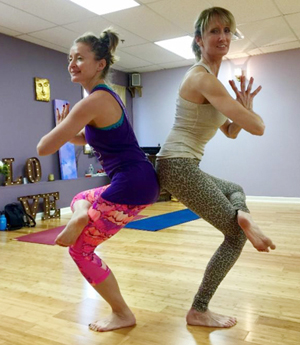
January Pose of the Month – Eka Pada Utkatasana (Standing Figure Four Pose)
By: Kim Shand
This is one of my go-to poses while waiting for baggage after a long flight. Figure Four offers a number of strength and stretch benefits for hips, piriformis and low back while also challenging your balance and ability to focus your mind.
How to do Eka Pada Utkatasana
• Start by assuming Utkatasana, Chair pose.
• Bring your hands to heart center.
• Get balanced and stable as you shift your weight into your right foot. You want to be solid in your whole footprint with a slight lift to your arch.
• Keeping your core strong, lift your left foot away from the mat, and place your left ankle across your right thigh, just about your knee. Keep your left foot flexed.
• Draw your weight back into your right heel.
• Let your left knee move toward the floor.
• Keep your hips level and sit back into your invisible chair while lifting your torso.
• Repeat on the other side
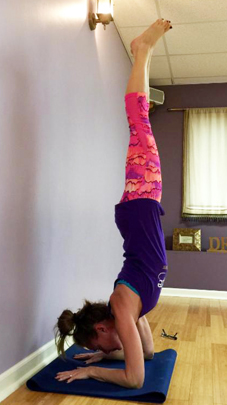
January Student of the Month – Lucy Slutsky
By Kim Shand
When I first started working with Lucy I was struck by her discipline and consistency. As I’ve had the opportunity to know her better I’ve been inspired by Lucy’s desire to gain a deeper and broader practice. She’s always ready to dive into the next challenge whether its physical or philosophical. Lucy’s hunger for knowledge about all things yoga prompted me to put her forward as January’s Student of the Month.
Meet Lucy:
Q: When did you begin practicing yoga and why did you start?
A: I began practicing yoga about three yrs ago. Playing tennis and working as a dentist I felt I needed a good stretching routine.
Q: What are or were some challenges you faced when you began your practice?
A: The 1st time I came to the studio, I came with a friend who had bought us a coupon to try Yoga. We came to Daniele’s open flow class not knowing what to expect. Daniele suggested I take a class for the beginners, but I was afraid I wouldn’t get a good stretch, since in my mind, beginner level meant not physical enough.
Of course, as I learned what it really means to practice yoga my competitive attitude changed. Now I approach my practice with calm mind and healthy curiosity. ” Where is my body today? What can I do today?” As I breath through different asanas my mind steadies, my focus increase and my body complies. At the end of each session I feel calm and in control. Empowered by my ability to control my mind and breathing pattern for over an hour.
Q: How did/do you overcome these challenges?
A: The challenge of practicing yoga is to show up. Once you show up and open your mind to a possibility, an amazing transformation will follow. When I came to my very first open flow class I was almost intimidated to see different level yogi doing some very complicated poses. Can you imagine doing yoga for the first time behind Alison Bernasco…? So I told myself I might be too old for inversions, but I can still get a good stretch. Isn’t that what I came there for in the first place?
Q: What is one pose you thought you would never be able to do, but now you can?
A: It is still to my own surprise but I pretty much can do all the poses my teachers offer. At least I can attempt them even those that seemed unattainable at one time. I thought Pincha Mayurasana, Adha Mukha Vrkdasana were for cirque du soleil people! I might be falling out of balance after few breathes and need to be assured by the wall but I can do it.
Q: What did you have to do mentally and physically to get there?
A: To be able to do tomorrow what I can’t do today I need to change. The change does not need to be drastic, small adjustments are cumulative. And then one day you think different your body is more flexible and intimidating poses are not as intimidating anymore…
Q: What advice would you give to someone who is apprehensive about starting a yoga practice?
A: Anything we start we start for the reason. Any reason leads to a result. Practice of yoga is a powerful tool and it should be seriously considered.
Q: What do you hope to gain from your practice going forward?
A: By practicing yoga I bring balance and sense of harmony into my everyday life. Yoga teaches me how to be happy. Is there a more important goal in life?
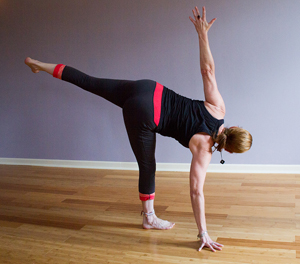
December Pose of the Month – Ardha Chandrasana
By: Roz
The Moon has a rich symbolic significance in yogic mythology. As a standing balance, Ardha Chandrasana (Half Moon Pose) encourages you to tap into the calm, balancing energy of the moon and at the same time the fiery force of the sun. Half Moon Pose helps you to discover how two opposing energies generate a power greater than its separate parts.
Your standing leg is rooting down into the earth while extending and lifting your raised leg into space. The two forces of rooting and extending provide you with the power to balance and suspend your spine in midair. You learn coordination and discover how the interdependent actions work in your body. Confronting challenging moments of balancing during your asana practice trains you to stay focused.
Benefits of Half Moon Pose
Sit on the floor with straight legs in front of you. Inhale and bend your knees so Developing strong legs and open hips are benefits of practicing Half Moon Pose. It is common for people to have one leg that is more dominant than the other, making the other weaker. By standing on one leg at a time both legs strengthen evenly. The weight of the body strengthens the standing leg by strongly engaging the outer thigh muscles. The raised leg is required to work to stay parallel to the floor by engaging lift from the inner thigh muscles and extension through the heel. Both legs are toned equally.
Additionally, Half Moon pose strengthens the abs, ankles, thighs, buttocks and spine. It stretches the groins, hamstrings and calves, shoulders, chest and spine. It improves coordination and balance. It can help relieve stress and improve digestion.
How to get into Half Moon Pose
1. Start with your legs in a wide stance (Ardha Chandrasana is often moved into from either Warrior 2 or Triangle Pose). Front toes facing straight ahead toward the front of your mat and back toes turned “in” about 20 – 30 degrees.
2. Look forward and bend your torso to the side over your front leg. Bend your front knee. Shift your hand a little in front and to the outside of your foot.
3. Glide your back leg in about half way up the mat. Continue to move forward until your shoulder and wrist are aligned. Fully extend the elbow to strengthen the fingers, wrist and arms.
4. Straighten and root into your standing leg to maintain a strong base. With your top hand on your hip keep your back leg straight and begin to lift it to hip height stacking one hip over the other.
5. Keep rotating the torso until your top shoulder is directly over the bottom one.
6. When you feel solidly placed extend the top arm straight up rotating your palm to the front of the mat and spread your fingers.
7. Continue to rotate the heart toward the sky, spread the collarbones and expand the chest. Breathing evenly will assist the balance.
8. Gaze up at your top hand if you are feeling stable. Hold this pose for 5 to 10 breaths. Enjoy the feeling of flying.
9. When you are ready to come out of the pose slowly, with control, step back to Triangle pose.
Options, props, add-ons to Half Moon Pose
1. A block under your hand can be used to give you the lift you may need to explore this posture.
2. Use a wall behind your back to assist you in finding the extension. This is a great option whether you are new to this asana or not. The wall is helpful in that it allows you to fully extend though all the limbs without compromised balance. This helps one really feel the proper alignment in Half Moon Pose.
3. Arha Chandrasana Chapasana or known as “Sugar Cane Pose” is something that you can add on once you have mastered the Full Moon Pose. After you are stable in Full Moon you can bend the knee of your top leg and reach your hand behind to catch hold of your foot. Keep your left thigh parallel with the floor. Draw the foot toward you with your hand and at the same time press your foot into your hand away from your body. The push pull of this action creates a bow shape in your spine turning the pose into a back bend. It also, creates an added challenge.
4. Lifting the supporting hand. When you have mastered both of these Half Moon options you can play with lifting the hand that is on the mat a few inches off the mat and eventually all the way to shoulder height. You can also take your supporting hand to your heart in half prayer.
5. After you have mastered Ardha Chandrasana you can move on to Parivrtta Ardha Chandrasana or Revolved Half Moon pose. This is achieved from Half Moon pose by squaring your hips by facing both hip points down toward the floor. Lower the top hand down. Bring the hand that was on the mat to your hip. Elongate your spine and twist around the axis of your spine. When you feel balanced extend your hand up from your hip. Continue to corkscrew through the whole spine until you eventually twist enough that you will be completely open as in the Half Moon. You will achieve length and breadth in your lungs, collarbones and chest.
Be patient with yourself as you practice Ardha Chandrasana, it takes a good deal of core, leg and back strength. It is well worth the effort you put in. Once you have it mastered Half Moon Pose is a pose that brings confidence, power and freedom.
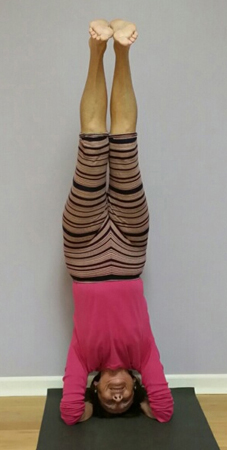
December Student of the Month – Lina Ferrara
By Roz
Lina Ferrara was an easy choice for student of the month. Her great energy and enthusiasm for her practice is inspiring. She is a regular attendee of my morning class at Ignite and keeps busy with many other activities such as dance and tennis. Her yoga practice is very impressive and would hearten other elders to take up yoga. She is proof positive that a yoga practice can be attained by anyone at any
age. I love her and love it when she attends my class!
Meet Lina:
Q: How long have you been practicing yoga?
A: Maybe 6 years. For me, it was some thing missing from my life. Most of what I did tended to be of an aerobic nature.
Q: What challenges you the most in yoga? (i.e.; breath work, relaxing, clearing
your mind)
A: Just to sustain the meditative mood through the class. I was the fidgety type of child.
Q: Do you have a favorite pose?
A: I guess down-dog because I can stretch my lower back.
Q: How has practicing yoga benefited you?
A: It really helps me to concentrate on inhaling and exhaling deeply.
Q: What advice would you give someone who would like to try yoga but is apprehensive about it?
A: Give it a try! What do you have to lose? Learn to relax as often as you can. Too much stress in this modern life!..
Q: What do you most like about Ignite Yoga Center?
A: The teachers are very patient and encouraging. There are more smiles there.
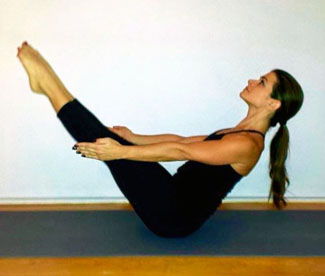
November Pose of the Month – Navasana
By: Christine V
Description & History
The yoga pose Paripurna Navasana, commonly referred to as Full Boat Pose in English, comes from the Sanskrit words paripurna meaning full or entire, nava meaning boat, and asana meaning posture.
The Full Boat Pose is a popular pose used to engage the core muscles by strengthening the abdominals and muscles of the pelvis and lower back. While the Full Boat Pose is a difficult yoga pose to perform for many, the benefits of the pose are long lasting.
How to Perform the Full Boat Pose
Sit on the floor with straight legs in front of you. Inhale and bend your knees so your feet are flat on the floor. Place your hands on the side of your thighs just below your hips, keeping your fingers pointed toward your toes. Exhale and slowly lean back at your hips lifting your legs, with bent knees,
a few inches off the floor. Make sure your back is straight as you draw your shoulder blades together to lift and open your chest. Slowly straighten out your legs. If you cannot straighten your legs, go as far as you can or follow the modified pose in the section below. Your thighs should be angled about
45 degrees from the floor as should your torso. From the side your body should look like a “V” with your arms still touching your thighs. Begin to slowly move your arms alongside your legs with palms
facing down until they are parallel to the floor. Hold the pose for 10-20 seconds to begin, gradually increasing the time you hold the pose to one minute. Release the pose by dropping the
legs and returning to the sitting position.
*To modify this challenging pose, bend knees while still using the core to hold your chest up
Modifications & Variations
When beginning the Full Boat Pose, you may find it difficult to straighten your legs. One modification of the pose is to start in a sitting position with your feet flat along the floor. Loop a stretching strap under the soles of your feet and grip the ends with your hands. On an inhale, lean back slightly at the hips while keeping the legs flat against the floor. On your next exhale, lift and straighten your legs, keeping the strap taut in your hands to help keep your balance and aid with stretching.
Another variation for beginners without a stretching strap is to use your arms for balance while in the
Full Boat Pose. Do this by starting with your legs flat against the floor, placing your hands about one foot behind your body. Exhale and lift your legs while leaning back at the hips.
Potential Health Benefits
• Strengthens and stretches core muscles (abdominals, hip flexors and lower back)
• Improves balance
• Stretches hamstring muscles of the legs
• Aligns and stretches spine
• Stimulates the thyroid, intestines, kidneys, and prostate gland
Precautions
Practitioners who are experiencing any of the following should consult their physician before attempting the Full Boat Pose:
• Diarrhea
• Asthma
• Heart problems (low blood pressure, high blood pressure, recent heart attack)
• Pregnancy
• Neck/back pain or injury
When performing the Full Boat Pose, it is important to shift your body backward and rest comfortably on your tailbone. This will allow for correct balance and reduce any unnecessary stress on the lower back.
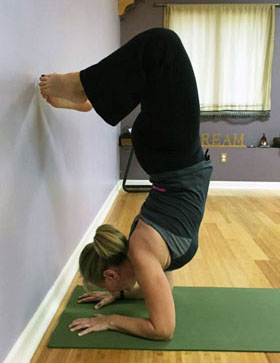
November Student of the Month – Linda Doherty
By Christine V
The choice for our student of the month was simple one for me: Linda Doherty. Linda is a regular at Ignite and you always know when she’s there because the room is a little bit brighter. She is also a personal hero of mine and I am lucky to know her! I had the opportunity to interview her and here’s what she had to say:
Meet Linda:
Q: When did you begin practicing yoga and what brought you here?
A: Yoga was a natural transition from dancing and far more enjoyable than the gym. Sonic Yoga opened two blocks down from where I lived in New York City and I became hooked on the vinyasa style. When I found Ignite Yoga and saw that Daniele had studied at Sonic I knew it would be the right place for me and I’ve been going ever since.
Q: What are or were some challenges you faced when you began your practice? (ie- breathing, relaxing, poses??)
A: I find breathing with the movements the biggest challenge. I breathe too slowly, controlling my
breath like I’m singing, and can’t keep my movements in sync. I’m working to match them up and
it’s helped with lift when jumping to the top of the mat.
Q: How did/do you overcome these challenges?
A: Keep practicing!
Q: What is one pose you thought you would never be able to do, but now you can? What did you
have to do mentally and physically to get there?
A: I don’t like to think I can’t do something. I just try, using all the tips from the teachers. I don’t
always get there, but when I do it’s such a great feeling.
Q: Over the past 2 years, you have, and continue to endure the most difficult time in your life. How has
returning to yoga helped you?
A: I kept going to yoga class as much as I could while Rob was undergoing chemo treatments because it gave me time to be. It was also important to both of us to stay strong and healthy and keep a regular routine for our boys. I went back to class soon after he died for the same reasons. It gave me “me” time
and helped me feel strong even though I wanted to fall apart. When I return to classes after missing for a while, usually for soccer games or family time, I can feel my mind and body become calmer. The stress level decreases and I’m a better mom.
Q: There are many gyms and yoga studios in the area. Why choose Ignite?
A: I joined Ignite because of Daniele’s connection to Sonic. I stay because I love the teachers and the atmosphere. And it doesn’t hurt that it’s so close I could walk! (if I wasn’t so busy!)
Q: What advice would you give to someone who is apprehensive about starting a yoga practice?
A: Just try it! And keep trying different classes until you find the one that fits you. Ignite is my fit!
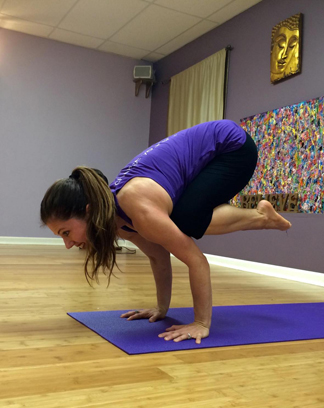
October Pose of the Month – Bakasana
By: Johanna Toth
Crow pose, or bakasana, is the first arm balance that most students learn, and it acts as the foundational pose that many arm balances are based upon. Although “Baka” is more accurately translated from Sanskrit as “crane”, this pose is most often referred to as “crow”. This pose stretches the upper back and groin and tones and strengthens the arms, shoulders, wrists and abdominal muscles and organs. Students may also find that bakasana improves balance, concentration, full body coordination and, eventually tranquility. Bakasana can be tricky to master but can be a fun pose once you get the hang of it! The key to bakasana is two-part.
1. Confidence and self-awareness, along with a mental resolve to let go of your fear of falling forward. Getting over your fear of possibly falling onto your face requires moving slowly with a calm mind. This focused mindset will help you reduce everyday stress and anxiety, leaving you feeling calm and self-assured. Another tip to avoid toppling forward is to maintain a constant gaze 12-20 inches in front of your mat. Try not to look directly down. You may even place a blanket or pillow in front of you until you feel confident with your balance.
2. Upper body and core strength.You may also find it helpful to practice asanas that directly strengthen your upper body and core, such as plank, chaturanga and forearm plank. The more that you can strengthen your core, the more accessible bakasana will be! And remember to breath. Bakasana allows for different levels of practice: beginners can place knees on bent upper arms, lifting only one foot at a time until sufficient strength and awareness is built. Beginners can also place a block under the feet, which will provide all of the physical benefits and will help the student acclimate to the balance shift. More advanced practitioners may straighten their arms, hop from bakasana to chaturanga, hop into bakasana from down dog or transition from bakasana to tripod headstand and then back to bakasana. There are so many options with this pose; making it one that can evolve and truly grow with your practices.
And remember to breath.
Bakasana allows for different levels of practice: beginners can place knees on bent upper arms, lifting
only one foot at a time until sufficient strength and awareness is built. Beginners can also place a block
under the feet, which will provide all of the physical benefits and will help the student acclimate to the
balance shift. More advanced practitioners may straighten their arms, hop from bakasana to chaturanga, hop into bakasana from down dog or transition from bakasana to tripod headstand and then back to bakasana.
There are so many options with this pose; making it one that can evolve and truly grow with your practice.
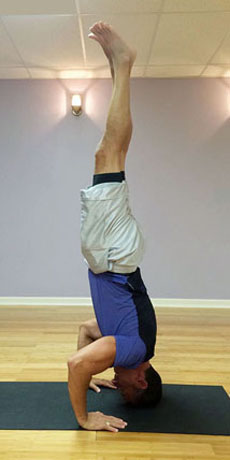
October Student of the Month – Anthony Gianino
A very active person, Anthony recovered flexibility of body and mind with his dedicated yoga practice.
Meet Anthony:
Q: How long have you been doing yoga?
A: “2 years”
Q: Why did you start?
A: “I was very interested in the spiritual aspect. Despite being very active I had lost flexibility.”
Q: What is your favorite pose?
A: “Crow and crow to head stand transition.”
Q: What do you like about yoga and how has it changed you both physically and spiritually?
A: “I have gained flexibility, balance and strength especially in my core.
Yoga has helped me live more in the present, to feel gratitude and appreciate what I have. It also facilitates in keeping me on track to live a calm and healthy lifestyle.”
Q: Where do you see your practice taking you in the next 5-10 years?
A: “I would like to continue to improve and perfect my practice and to stay healthy as I move from my mid 50’s to the later years of life.”
Q: What would you say to someone contemplating yoga?
A: ”I would tell them to embrace all aspects of yoga: mind, body, and spirit. It is much more than a form of exercise and you will appreciate it more if you understand this and go into it with an open mind.”
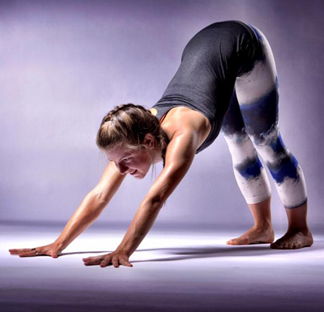
September Pose of the Month – Adho Mukha Svanasana
Adho (downward) Mukha (facing) Svana (dog) asana (posture)
By: Alison Bernansco
From hands and knees curl your toes under, lift your hips and extend your thighs back. Your hips will become the apex of your pose. You can gauge how far to place your hands and feet in relation to one another by coming forward into plank pose and pressing back into down dog. Palms are flat*, shoulder width apart, pointer fingers (or, some people prefer middle fingers) parallel. Arms are straight, you’re winging out the lats (cape shaped muscles of the mid-upper back) to broaden the surface of your back, and you’re pushing the ground away to create space in your shoulders. *The palms are energized (we call this a ‘hasta bandha’), and though the metacarpals (where the fingers meet the base of the palm) and fingerpads are grounded, the inner arch of the palm is ever so slightly lifted. You can think of ‘suction cup’ hands, or the action it would take to palm a basketball under each hand.
Gaze is a few inches in front of the vicinity of your toes unless instructed otherwise (don’t be fooled by me checking out my hasta bandha in this pic!). Soften at the base of your neck to free up space, and let the weight of your skull help you to release more deeply. If you temporarily gaze all the way to your feet you should find them hips width apart and parallel. Heels may never touch the ground, that’s an anatomical thing you may or may not be built for, so instead let them migrate in the direction of earth while simultaneously stretching the heels of your feet toward the back
of the room.
Thigh muscles (quadriceps) activate to lift your kneecaps and press your thigh bones straight back, as your sitz bones (the rings of bone at the base of your pelvis) reach back and apart. Give this pose time to become a ‘resting place’. If it’s new, you can expect it to be a challenge! With each practice, notice yourself able to spend more time comfortably in your Down-Dog. Remember, yoga doesn’t happen all at once. The poses start when you’re ready to leave them.
Magic takes time, trust the process.

Student of the Month – Angela D’Addario
Angela is an inspiration to watch and a pleasure to have in the studio. She puts her all into the practice with humor, consistency and grace. Please read about how she overcame a serious injury and made it back to the mat.
Meet Angela:
“I have been practicing for 6 years. My favorite asana is Dancer because I think it is such a beautiful pose. Even though I struggle wirh balance, I love when this pose is part of a sequence.
Yoga has allowed me to learn so many life lessons and I have definitely had the opportunity to use these lessons in my everyday life. The biggest things I have learned are: It’s the journey, not the destination, and nothing lasts forever. Both the good times and bad are temporary.
I have two words for anyone thinking about yoga- DO IT! Don’t worry about everyone else, just honor where you are and you will be amazed at what you can do.
Recently, I sustained a serious injury to my foot. Although I was unable to practice yoga for several months, the spiritual component of my practice became so important and again, presented me with opportunities to learn additional life lessons. The ability to embrace and love who you are makes each step forward a celebration of your strength, instead of a reminder of your current situation.
When you return to your mat after an extended absence, embracing the various modifications that may be needed, is another challenge that requires patience. Let go of worrying about starting over. Don’t compare your new practice to where you were before your injury. Although this may not be a journey that you would have chosen, it did happen for a reason and as we hear all the time, we are exactly where we are supposed to be!”
